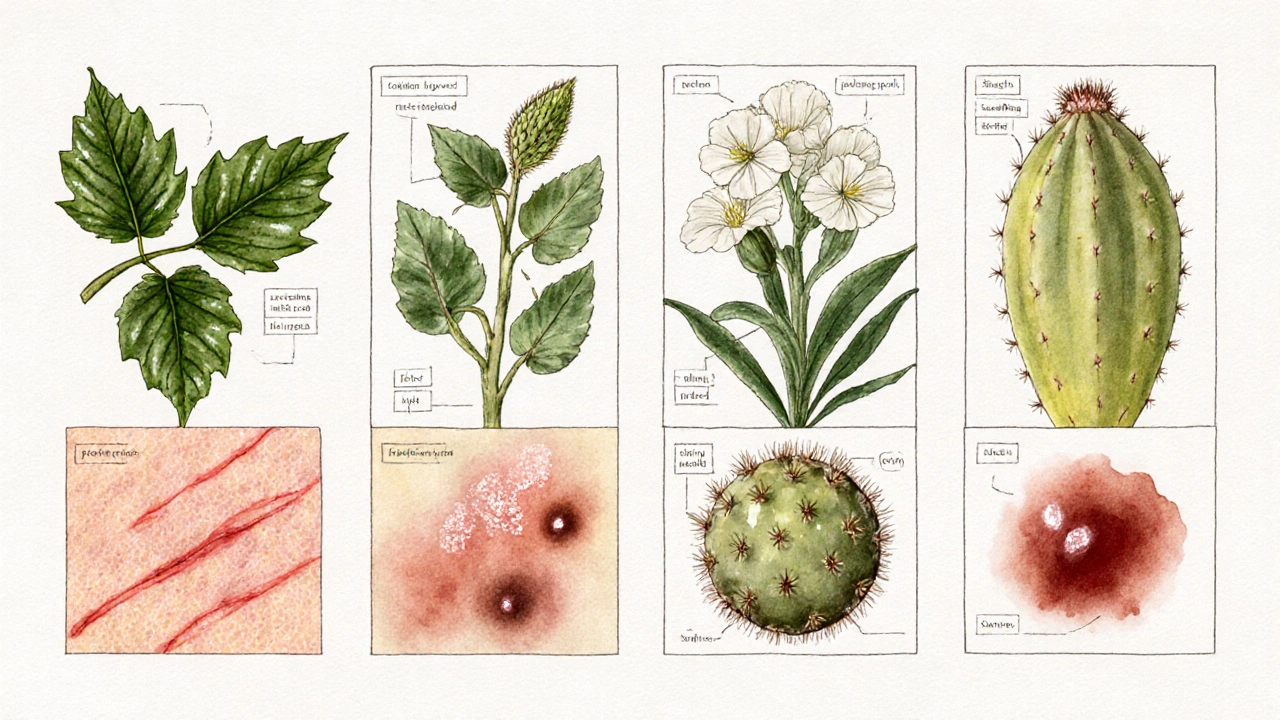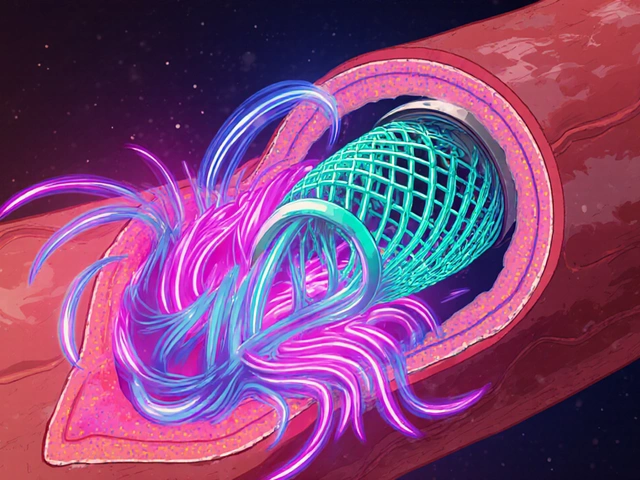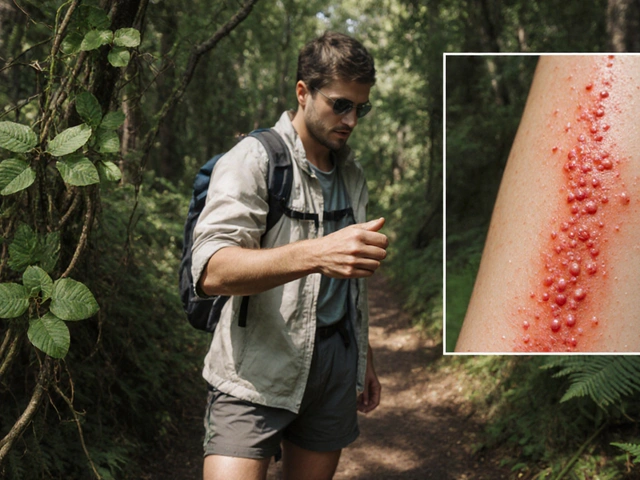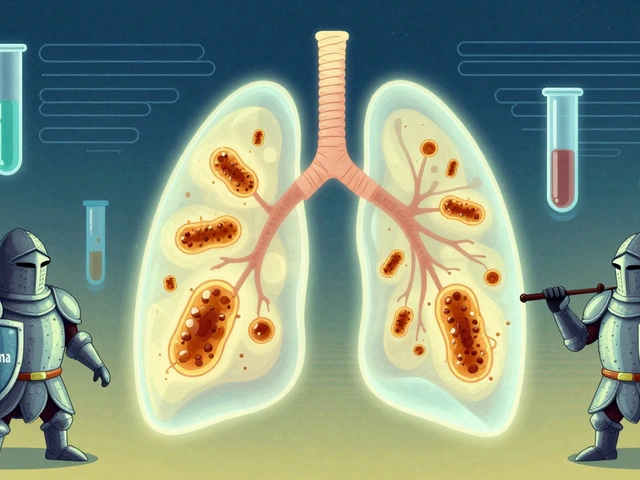Plant Rash Identifier
Potential Plant Cause:
Symptoms Matched:
First-Aid Recommendations:
Common Plants & Their Rashes
Poison Ivy, Oak, Sumac
Toxin: Urushiol
Typical Symptoms: Linear red streaks, itchy papules, blisters
Giant Hogweed, Parsnip
Toxin: Furanocoumarins
Typical Symptoms: Burning, swelling, delayed dark patches (photodermatitis)
Stinging Nettle
Toxin: Formic acid & histamines
Typical Symptoms: Stinging sensation, red welts
Cactus (Prickly Pear)
Toxin: Barbed spines + latex
Typical Symptoms: Localized redness, swelling, sometimes sterile pus
Ever wondered why a casual hike leaves you with a red, itchy patch that won’t quit? Most of the time it’s not a mysterious infection - it’s a plant‑related skin rash. This guide shows you how to spot the culprit, what makes the reaction happen, and which home remedies or medical options actually work.
Quick Facts
- Most plant rashes are a form of allergic contact dermatitis caused by oils like urushiol.
- Key offenders: poison ivy, poison oak, poison sumac, and plants that cause phytophotodermatitis (e.g., giant hogweed).
- First‑aid steps: wash area within 15minutes, apply cool compress, avoid scratching.
- Mild cases usually clear in 1-2weeks; severe or widespread rashes may need prescription steroids.
- Prevention is easier than cure - learn to identify high‑risk plants before you step into them.
What is a Plant‑Induced Skin Rash?
Plant‑induced skin rash is an inflammatory skin reaction that occurs after direct contact with certain botanical toxins. It typically appears as red patches, swelling, and intense itching, sometimes developing blisters.
How the Reaction Happens - The Science in Plain English
When the skin meets a plant’s chemical irritant, the immune system thinks it’s an invader. Urushiol is the oily allergen found in poison ivy, oak, and sumac. It binds to skin proteins, and within hours T‑cells (a type of white blood cell) launch an attack, releasing histamine and other inflammatory mediators. That’s why the area becomes red, warm, and itchy.
Another pathway is phytophotodermatitis - a reaction that needs both a plant’s photosensitizing chemicals (like furanocoumarins) and sunlight. The chemicals alter DNA in skin cells, and UV exposure amplifies the damage, leading to painful, often blistering lesions that may turn brownish as they heal.
Common Plants & Their Signature Rashes
| Plant | Toxin | Typical Symptoms | First‑Aid Tip |
|---|---|---|---|
| Poison ivy, oak, sumac | Urushiol | Linear red streaks, itchy papules, blisters | Wash with soap & water within 15min |
| Giant hogweed, parsnip | Furanocoumarins | Burning, swelling, delayed dark patches (photodermatitis) | Rinse with cool water, avoid sun for 24h |
| Cactus (esp. prickly pear) | Barbed spines + latex | Localized redness, swelling, sometimes sterile pus | Remove spines, apply cold compress |
| Stinging nettle | Formic acid & histamines | Stinging sensation, red welts | Wash, apply aloe or calamine |
| Ragweed (indoor foliage) | Allergenic pollen proteins | Itchy rash, especially on face & neck | Antihistamine, avoid exposure |
Step‑by‑Step: Identify the Plant Behind Your Rash
- Recall where you were when the rash started - park, beach, garden?
- Look for tell‑tale growth patterns: poison ivy leaves grow in clusters of three, with glossy edges.
- Check for recent sun exposure if the rash is on exposed skin - suspect phytophotodermatitis.
- Notice the rash shape: linear streaks usually mean a brush‑contact with a vine; round patches might point to a cactus spines.
- Take a photo and compare it to reputable field guides (New Zealand’s native flora guide, online plant ID apps).
If you still can’t pinpoint the plant, treat it as an allergic contact dermatitis until a professional evaluates it.

First‑Aid Checklist - What to Do Within the First Hour
- Wash the area: Use lukewarm water and mild soap. Soap helps dissolve oily allergens like urushiol.
- Cool compress: Apply a clean, damp cloth for 10‑15minutes to reduce swelling.
- Avoid scratching: Scratching can break the skin, leading to infection.
- Remove plant material: Gently brush off any remaining spines, hairs, or sap.
- Apply soothing agents: Aloe vera gel, calamine lotion, or a 1% hydrocortisone cream can calm itching.
When to Reach for Over‑The‑Counter (OTC) Relief
OTC options work best for mild to moderate itching and swelling.
- Antihistamines such as cetirizine or diphenhydramine block histamine release, easing itch.
- Topical corticosteroids like 1% hydrocortisone reduce inflammation when applied twice daily.
- Calamine lotion provides a cooling, drying effect on weepy lesions.
Follow package directions - usually a 7‑day limit for steroids to avoid skin thinning.
Prescription Treatments for Severe or Widespread Rashes
If the rash covers large body areas, blisters are numerous, or it spreads quickly, see a healthcare professional. They may prescribe:
- Oral corticosteroids (e.g., prednisone) for rapid inflammation control.
- Stronger topical steroids (clobetasol) for stubborn patches.
- Antibiotics if secondary bacterial infection is suspected.
Remember, steroids are powerful - use only under medical supervision.
Preventive Habits - Stay Safe on Your Next Outdoor Adventure
- Wear long sleeves and gloves in areas where poison ivy or hogweed grow.
- Carry a small bottle of rubbing‑alcohol-based cleanser for immediate decontamination.
- Learn the three‑leaf rule for poison ivy, oak, and sumac.
- Apply broad‑spectrum sunscreen if you’re in a region prone to phytophotodermatitis, even when you’re not planning a beach day.
- Wash clothing and pets that may have brushed against offending plants - the oil can linger for months.
Quick Reference Checklist
- Identify plant (leaf shape, growth habit)
- Wash within 15min
- Cool compress & soothe
- OTC antihistamine + 1% hydrocortisone
- Monitor: if spreading, blistering, or fever develops → see doctor
- Prevent future contact: clothing, knowledge, cleaning
Frequently Asked Questions
Can I get a rash from a plant I only touched briefly?
Yes. Even a quick brush with urushiol‑containing plants can transfer enough oil to trigger a reaction. That’s why immediate washing is crucial.
How long does a poison‑ivy rash typically last?
Mild cases usually resolve in 7‑10days. More severe eruptions with extensive blistering can linger up to three weeks, especially if the skin isn’t kept clean.
Is it safe to use home remedies like baking soda paste?
Baking soda can neutralize itching for minor irritation, but it won’t counteract the underlying immune response. Stick to proven options (soap wash, antihistamine, steroid) for best results.
Can I develop a tolerance after repeated exposure?
Unfortunately, repeated contact usually worsens sensitivity. Each exposure can boost the immune system’s memory, leading to faster and stronger reactions.
What’s the difference between phytophotodermatitis and a regular contact rash?
Phytophotodermatitis needs both a plant’s photosensitizing chemicals and UV light to cause damage, often resulting in blistering and darkened patches. A regular contact rash is solely the immune response to the plant’s irritant.
Armed with the right knowledge, you can enjoy the outdoors without fearing that unwanted plant skin rash. Spot the plant, act fast, and treat correctly - your skin will thank you.






Mangal DUTT Sharma
October 3, 2025 AT 10:03Wow, that guide on plant‑induced rashes is a treasure trove of info! 😊 It walks you through the science behind urushiol and furanocoumarins in a way that even a layperson can grasp. I love how it starts with the classic three‑leaf rule for poison ivy, oak, and sumac, because that’s the first thing hikers need to know. The step‑by‑step identification checklist feels like a mini‑field guide you can carry in your pocket. The first‑aid section emphasizes washing within 15 minutes, which is absolutely critical – the sooner you remove the oil, the less severe the reaction. It also mentions cool compresses and the importance of avoiding scratching, which can prevent secondary infections. The breakdown of common culprits, from stinging nettle to giant hogweed, is thorough and includes the specific toxins involved. I appreciate the separate sections for OTC treatments and prescription options; it helps people self‑triage before seeing a doctor. The preventive habits list is a nice touch, reminding us to wear gloves and long sleeves in high‑risk areas. The FAQ at the end answers the most common doubts, like the duration of a poison‑ivy rash and whether you can build tolerance. Overall, the guide is both scientifically accurate and practically useful – a perfect blend for outdoor enthusiasts. 🌿
Gracee Taylor
October 7, 2025 AT 14:03This article really nails the balance between detail and readability. I liked the clear bullet points for first‑aid steps; they’re easy to follow when you’re in a panic. The inclusion of photos for leaf identification would make it even better, but the written descriptions are solid. Definitely going to bookmark this for my next hike.
Leslie Woods
October 11, 2025 AT 18:03Great guide for anyone who gets a rash after a walk in the woods.
Manish Singh
October 15, 2025 AT 22:03Nice write‑up! I think the tip about washing within 15 minutes is often missed by most people. also the bit about cleaning clothes and pets is super useful, many dont think about that side effect. If you ever get a rash, just follow the steps and you should be fine.
Dipak Pawar
October 20, 2025 AT 02:03From a botanical standpoint, the guide does a commendable job of linking specific phytochemicals-urushiol, furanocoumarins, formic acid-to their dermatological manifestations. The pharmacodynamic explanation of T‑cell mediated hypersensitivity is succinct yet accurate, which is rare in lay‑focused health articles. Moreover, the delineation between contact dermatitis and phytophotodermatitis is crucial for differential diagnosis in field conditions. The preventive protocol-protective apparel, immediate decontamination, and post‑exposure sunscreen-mirrors best practices outlined in toxicology manuals. Overall, the synthesis of clinical and ecological information elevates this piece beyond a simple how‑to.
Jonathan Alvarenga
October 24, 2025 AT 06:03Alright, let's cut to the chase: this guide is way too long for what most people need. Sure, the science is there, but if I’m itching on a trail I don’t have time to read about T‑cells. The first‑aid steps are buried under layers of text; they should be front and center. Also, the list of plants feels endless-pick the top three and stick to them. And why does every paragraph end with a bullet list? Just give me a quick cheat sheet, not a dissertation.
Jim McDermott
October 28, 2025 AT 09:03I appreciate the friendly tone of this post. It makes a potentially scary situation feel manageable. The practical tips like carrying a small bottle of alcohol cleanser are spot on. Anyone out there who’s dealt with a nasty nettle sting will know how soothing aloe can be. Thanks for the solid info!
Naomi Ho
November 1, 2025 AT 13:03As a dermatologist, I can confirm that washing with soap within the first 15 minutes dramatically reduces urushiol absorption. The guide also correctly notes that topical hydrocortisone 1% is appropriate for mild cases. For severe blistering, a prescription‑strength steroid may be necessary, as the article mentions. Keep an eye on secondary infection signs-redness spreading, pus, or fever-and seek care promptly. This is solid, evidence‑based advice.
Christine Watson
November 5, 2025 AT 17:03This is exactly the kind of positive, empowering content we need! 🌞 It reminds us that knowledge is the best protection against those nasty plant rashes. I love the encouragement to enjoy the outdoors while staying safe. The quick reference checklist at the end is super handy for a rapid review. Keep up the great work, and happy hiking!
Macy Weaver
November 9, 2025 AT 21:03I think the guide does a good job of staying neutral while still being helpful. The step‑by‑step identification process feels accessible. Also, the mention that repeated exposure can increase sensitivity is an important warning. It’s nice to see both OTC and prescription options covered without pushing any agenda.
James McCracken
November 14, 2025 AT 01:03One could argue that the very act of categorizing rashes into “plant‑induced” versus “other” is a philosophical reductionism that ignores the holistic interplay of environment and organism. Yet the guide persists in this binary, perhaps for the sake of pragmatism. Does one not then sacrifice the nuance of individual physiological variability for the convenience of a checklist? Nonetheless, the necessity of prompt decontamination is an undeniable truth, transcending epistemological debates. In the end, the text serves both as a practical manual and a subtle reminder of our limited grasp on nature’s complexity.
Evelyn XCII
November 18, 2025 AT 05:03Sure, this guide is thorough, but let’s be real-most people will just slap on some generic cream and hope for the best.
Adrian Hernandez
November 22, 2025 AT 09:03Reading this makes me wonder why the government doesn’t warn us more loudly about these plants. They’re out there in plain sight, and yet the information is tucked away in an article like this. If they really cared about public health, they'd put up signs on every trail. Anyway, good stuff, but stay vigilant-the world is full of hidden dangers.
duncan hines
November 26, 2025 AT 13:03Oh wow, another “comprehensive guide” that pretends to be the ultimate authority on plant rashes! 🎭 I can already hear the dramatics: “Wash within 15 minutes or your skin will be doomed forever!” As if we’re all sitting there with a lab beaker, ready to rinse away the apocalypse. News flash: most of us just want a quick fix, not a theatrical lecture. Still, kudos for the length-makes me feel like I’ve read a novel.
Mina Berens
November 30, 2025 AT 17:03Interesting read! 😎 The short version is: identify, wash, soothe, and don’t panic. Simple enough for anyone out there on a trail.
Chris Meredith
December 4, 2025 AT 21:03Yo, the energy in this post is on point! The jargon about furanocoumarins might sound heavy, but it’s crucial for those of us who love the science behind the itch. Also, the suggestion to carry a portable alcohol wipe is a game‑changer for field medics. Remember, proper PPE-gloves, long sleeves-reduces exposure risk by up to 80 %. Stay hype, stay safe.
Jessie Eerens
December 9, 2025 AT 01:03Indeed, the guide is thorough; however, one might consider the occasional omission of ancillary details that could enhance practical application. Nonetheless, it is commendable.
Caroline Lane
December 13, 2025 AT 05:03Honestly, I’m not surprised people get rashes-nature’s random and we’re clueless most of the time. The guide is okay, but you still gotta rely on your gut. If it burns, just cool it. If it swells, maybe see a doctor. End of story.
Geneva Lyra
December 17, 2025 AT 09:03Hey folks, nice to see a detailed post like this! I’ve seen many people ignore the cleaning of clothes and pets-big mistake, as the oil can linger. Also, remember that even if you’re not directly touching the plant, wind can carry the irritant. Stay safe out there and share this info with your hiking buddies.